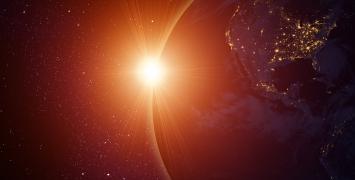Exploring the potential of new orbits for future space services
Space exploration may one day reveal clues to the origin of the universe and life on Earth. In the meantime, scientific advances in the field have supported “space services” for everyday life such as weather forecasts and satellite navigation on our phones. With his ERC grant, space engineer Prof. Colin McInnes explored the mathematics of new families of orbits around the Earth for spacecraft, from micro-satellites to large solar sails. The objective was to map these orbits and to uncover potential applications for new space technologies in fields as diverse as space science, Earth observation and telecommunications.

“Space has a huge impact on our lives,” says Prof. McInnes, “but it is invisible to us. It is amazing to think that a technology such as satellite navigation which thirty years ago was only available to the military is now embedded in our smartphones and available at the touch of a button. When we look at a map on our phones using satellite navigation the locational point is the top of a pyramid which stretches right back to the rocket which launched the satellites into space”. Space technology is now harnessed for a wide variety of civilian uses – telecommunications, monitoring crop growth, urban development and climate science.
At the Advanced Space Concepts Laboratory, Prof. McInnes' team has used an ERC Advanced Grant to explore the potential of various orbits, both close to and far from Earth, to support future space products and services. They used mathematical modelling to understand how natural forces such as light pressure from the sun can generate new families of orbits, for example using the pressure of sunlight on a large reflective sail to hover stationary over the poles of the Earth for climate science observations.
Capturing asteroids
Prof. McInnes’ fascination with space began as a young child gazing at a picture of a rocket on his Junior School classroom wall. Add to this an inspirational physics teacher at High School demonstrating projectile motion and he was hooked. Through the VISIONSPACE project, his team also investigated Near Earth Objects (NEOs) – asteroids or comets in orbits close to that of the Earth. The team has looked into how they could exploit the natural effects to manipulate the orbits of NEOs, ultimately to engineer some of them for capture at the Earth and exploitation for future in-space resource use.
In the course of the project, the team discovered a new class of easy-to-capture asteroids that could be mined for raw materials in the future to support future space ventures. Within a catalog of 10,000 space objects, the researchers identified a new category of “Easily Retrievable Objects” (EROs) and 12 fairly small asteroids, ranging in size from approximately 2 meters to 60 meters in diameter, which could be captured with existing space technology. Applications include baking water out of small asteroids using heat from the Sun to provide resources for future human space exploration.
The researchers also recently calculated ways to use so-called “sticky” orbits, where the asteroid is not strictly captured but would remain at an accessible distance from the Earth. Their method, yet to be developed and put to the test, could be cheaper than others currently considered by space agencies.
The freedom to think
Prof. McInnes describes the ERC funding as “a fantastic opportunity and essential to the health and wellbeing of the European research base because it is the only funder which is supporting unconstrained frontier research in this way.” In the context of his five-year VISIONSPACE grant, it meant that the team was encouraged to pursue curiosity-driven research, not least because they were freed from the need to regularly re-apply for funding.
The funding led to the establishment of a new Space Institute at the University of Strathclyde, a regional Centre of Excellence in satellite applications and strong links with Glasgow-based CubeSat manufacturer Clyde Space Ltd. It also gave the research team the time and space to explore unexpected ideas, such as applying prior research by astronomers on the orbits interplanetary dust to design new ways of removing space debris, such as old satellites or spacecraft fragments, ultimately “cleaning space”.
Since finishing his ERC project Prof. McInnes has moved to the University of Glasgow, where he is James Watt Chair, Professor of Engineering Science and hopes to bridge the forthcoming centenary of his Chair with the intellectual possibilities of science and engineering of the next hundred years – further opening the “envelope of possibilities for our future”.






